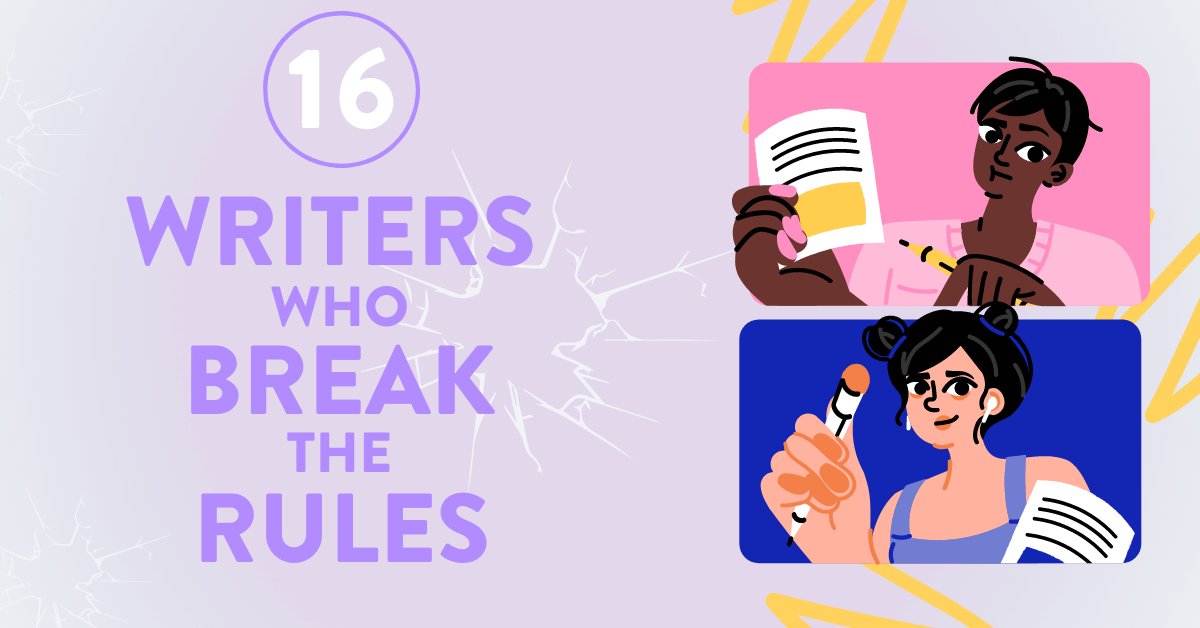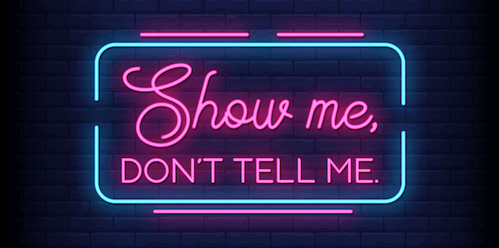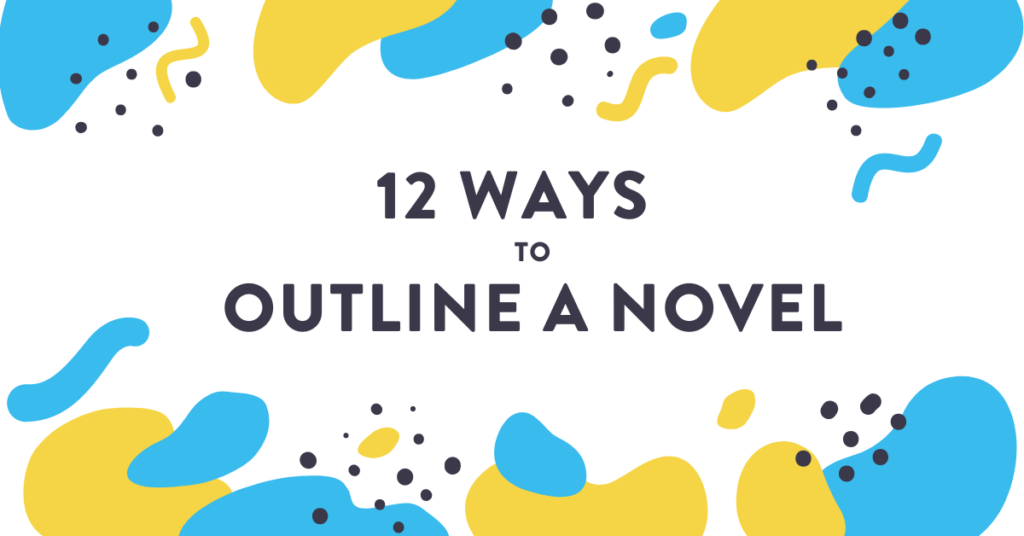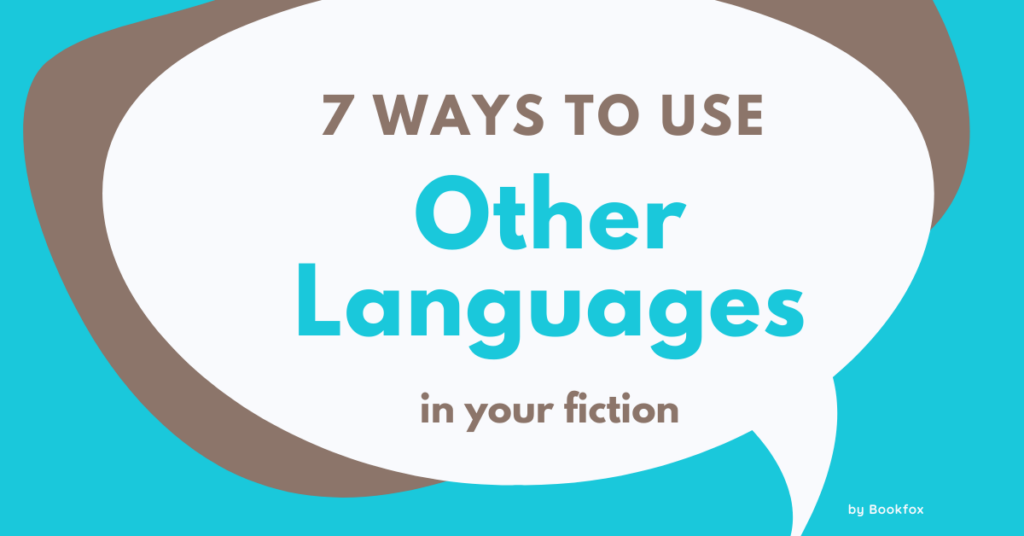
Any time some well-intentioned writer tells you, “You can’t do that” in your story, please send them this article.
Because this article celebrates breaking the rules!
Here are more than sixteen writers who deliberately break the rules of narrative to make their book better.
The twenty writers below gleefully and blatantly shatter the most fundamental storytelling rules. I’m talking about the most basic moves, stuff like:
- active protagonists
- don’t switch point of views
- too-perfect characters
- grammar/punctuation
- Show, don’t tell
When to Break the Rules
Break these rules once you have some writing experience.
If you’re a beginner, I wouldn’t recommend trying to pull off these techniques. You have to learn how to do a cartwheel before you can master the aerial double-backflip on the trapeze.
But if you have some writing experience under your belt, then experiment with these advanced writing techniques. Read the books, see how they do it, then be playful in your writing.
Why Break the Rules?
Don’t break the writing rules just for the sake of shocking the reader.
Do it because the book requires it. Because it’s the best and most interesting way to tell the story. Because the book wouldn’t be as good if you shoved it into the little box of rule-checking.
1. Heroes Not Solving Problems

At the end of “War of the Worlds,” by H.G. Wells, the aliens are defeated.
Normally, we would assume that the protagonists have defeated them somehow, or at least the humans in government have vanquished them. That would be the most emotionally fulfilling storyline, the one that readers would expect.
But nope! This is a perfect Deus ex Machina ending (God from the machine). Basically, all the aliens get sick with earth germs and all die.
So people fought the aliens for the entire book, but nothing they did ever made a difference, and then the aliens died not as a result of anything the characters or humans did.
How does this still work? Well, the book is kind of saying that we can’t fight a superior race. We would lose for sure. And yet he didn’t want the aliens to win, so he broke the storytelling rules so humans could win in the end.
2. Passive Main Characters

In “The Goldfinch,” by Donna Tartt, we reach the climax of the story. Apparently, the climax does not involve the main protagonist going out and, you know, doing something.
No, in this case, the main character just sits in a hotel room. Boring, boring boring.
While his friend Boris goes out and accomplishes the main event of the entire novel. We don’t even get to see it firsthand through Boris’s point of view — we hear about it later, when Boris tells the main character what happened.
This truly breaks all the storytelling rules about making your main character active, especially at the climax.
3. Flawless Main Character

Every character has to have flaws, right?
If a character is flawless, they seem fake and unrealistic, and your readers won’t identify with them.
There’s even a term for this: If a flawless character is female, they are called a “Mary Sue” (not to be confused with a Mary Jane).
But …
There are some flawless characters out there and somehow they work. Take for example Prince Myshkin, in Dostoevsky’s “The Idiot.”
The prince is genuinely flawless. He’s the nicest person ever. The closest thing he has to a flaw would be a medical condition: he’s an epileptic. But certainly no character flaws.
And yet Dostoevsky makes the story work by having everyone hate him. See if you have a perfect character, you still have to create conflict, so if you make your other characters resent your perfect character’s superiority, voila! You have a story.
4. Single Location

Novels need to move, right?
Only plays are set in one location, but novels don’t have the limitations of a stage, so it would get boring to have the story all in one place.
Except …
Nicholson Baker did not get that memo. His novel “The Mezzanine” takes place entirely inside an elevator.
That’s right, a 142 pages of an elevator conversation (it’s very dialogue heavy, obviously).
And it’s a delight to read, because Baker is wildly inventive and smart and he’s created a wild, nutty narrator that entertains you constantly throughout these pages.
He takes the smallest, most mundane details in life and makes you marvel at it, and consider how wonderful and magical it is.
5. POV Switching
It’s widely considered a mistake to switch point of view right in the middle of your story, especially from 1st person to 3rd person.
It’s disorienting for the reader, because one minute they’re being told about these characters, and the next minute they’re hearing from the characters themselves.
But …
Check out Barbara Kingsolver’s “The Bean Trees” (you might know her more famous book, “The Poisonwood Bible.”)
The first chapter is 1st person, and the next chapter is 3rd. They keep on alternating like that throughout the book.
To break this rule well, you just need a chapter break. As long as you create a chapter break, you can switch between 1st person and 3rd person with ease, and the reader won’t be confused.
Honestly, not confusing the reader is probably at the heart of lots of these so-called rules. As long as they understand what you’re doing, they will come along on the ride.
6. Head Hopping

This is another POV mistake.
When you’re writing in omniscient, you’re not supposed to tell the reader about the thoughts of one character, then jump into another character’s thoughts. Hopping between heads is simply confusing.
And yet …
I do see it done semi-frequently, especially in sci-fi books like Frank Herbert’s “Dune” and Philip K. Dick’s “Do Androids Dream of Electric Sheep.”
Both novels head hop in the opening pages.
It’s usually not obnoxious.
There’s just a little sentence after a line of dialogue where we skip into a second character’s head. And I will say that I almost never see head-hopping between a whole group of people.
When this rule is broken, there are usually only two characters in the scene and you momentarily drop into a second character’s brain.
Still, this is one mistake that I refuse to do. You have to have a personal code of conduct for your writing, a sensibility about what rules you will break and you won’t break.
I’ll break most of the other rules on this list, but this one is sacred to me. You make your own decision.
7. Mixing Genres
This is a mistake that agents get particularly angry about.
They can sell a nonfiction book, they can sell a graphic novel, they can sell a novel, they can sell poetry (just kidding — no agent represents poetry). But if you start to mix those genres, they throw up their hands in frustration.
That’s because the book buying market loves to pigeonhole books.
But …
Sometimes you have a vision for a book that includes multiple genres. A play, a memoir, a graphic novel, and poetry, all bound up into one crazy book.
If that’s your idea, I’d say go for it. Julio Cortazar does in “The Winners.”
“The Winners” is fiction; it’s a novel. And yet he includes these wild poetic interludes. They don’t seem to connect to the storyline at all. They create more of an ambience for the narrative, and they’re fascinating to read.
8. Chronological Order
It’s not a mistake to play with chronology in your book.
A million books have started at the end and then backtracked to tell the events that lead up to that ending.
But what is considered a mistake is reversing time.
Except …
Just like the movie Memento, Stephen Elliott’s novel “Happy Baby” is told in reverse order. Total reverse order, not just shuffled chronology.
The character starts as an adult and then slowly the story moves backwards in time to reveal the trauma the character suffered as a child.
It’s an ambitious structure, and highly unusual, but if the climax of your story happens when your character is a child, then you can probably pull it off, because the level of events (from low to high) supersedes the chronology of events (from first to last).
9. Show, Don’t Tell

This rule could also be phrased as: create scenes, not summary.
In general, it’s a good idea to show the reader what is actually happening, rather than merely telling them about a large section of time.
But …
This is a rule that has been broken often, most often by the greatest writers who have ever lived.
Certainly the South American writers break this rule all the time — the first that sprang to mind was Roberto Bolano.
He summarizes wildly — entire dinners in a paragraph, entire months in a page, summarizes conversation and trips and desires. He tells you constantly rather than showing you.
Another good example would be all of Elena Ferrante novels. She lets you hear the ticker-tape of her character’s thoughts, rather than immersing you in set scenes with beginnings and ends.
When this rule is broken frequently, the resulting novel feels less like a movie and more like access to a character’s inner sanctum of thoughts and fears. It’s very intimate.
If you want to get better at writing summary, make sure to check out my post on 4 Ways to Write Summary.
10. Picking One Tense
This is a pretty wild rule to break.
I mean, sticking to a single tense seems like a no brainer. And sure, you can write in simple past tense and then use simple past perfect (“had”) to describe an event in the past, but that doesn’t break any rules.
Yet …
There are some writers who will switch tenses in the middle of a scene. It’s present tense, and suddenly it’s past tense. And then back to present.
Mo Yan did this in “The Garlic Ballads.” He flipped from present to past often with no warning or chapter break. And then changed back again.
I’d say this is one of the most dangerous rules to break, though. You have to have an excellent reason why you’re cycling through different tenses, but it’s unnerving for the reader.
If you want to learn more about this, I’d suggest reading Toni Morrison’s “Beloved”, which also plays with switching tense.
11. Avoiding Quote Marks

Punctuation is pretty standardized. It’s odd to see a rebel breaking the rules.
But …
In the last thirty years, there has been a trend of authors who refuse to put quote marks around dialogue.
For instance, Cormac McCarthy’s “Blood Meridian.”
Not only does he avoid quote marks around dialogue, he tries to avoid punctuation as much as possible, including commas (though he still uses periods, God bless him).
Readers have two minds about this:
- Some readers despise it. They will savage review a book that eschews punctuation rules.
- Some readers feel like it gives the book a stripped-down feel, which changes how they read the storyline. It makes it feel more hardscrabble — the lack of punctuation compliments the story they’re trying to tell.
As a reader, avoiding quotation marks makes it more difficult for me to read, so I tend to avoid breaking this rule. But if you have a certain type of story, and you’re not worried about offending some readers, this might be a good rule to break.
12. Consistent Style
Your book is supposed to sound the same, isn’t it?
I mean, if you’re writing simple, mono-syllabic words like Hemingway in the beginning, and yet by the end you’ve switched to flowery, Faulkner-type complex prose, then the reader is going to wonder whether a ghostwriter took over your story halfway through.
In general, consistency of prose is wise. It makes the reader feel like they can trust the author, and the book holds together.
But …
In “Flowers for Algernon,” we have a first person story that starts simple, elevates into Ph.D. level academic prose, and then sinks back to simple language.
That’s because the narrator is being experimented on, and at first he’s very simple-minded, then becomes wildly intelligent, and then sinks back into being dim-witted.
So the prose mimics what’s happening with the character’s mind.
Another example would be “The River Why” by David James Duncan, one of the best novels ever on fly fishing.
The novel starts with free-flowing, free-wheeling prose that does cartwheels and handstands, yet by the end of the book it’s calmed down into much neater, organized sentences.
13. Non-Sentient Narrators

It’s usually a rule that your novel is narrated by a human.
This makes sense. We humans tend to care about other humans.
However …
There are a number of books out there that flaunt this basic rule.
In “The Overstory” by Richard Powers, part of the book is narrated by a plant. Specifically, a tree.
And though it’s semi-common to have animals narrate a book, having a plant to do is quite rare.
Also, “Delicious Foods” by James Hannaham is partly narrated by crack cocaine. That’s right, by the drug itself.
And trust me, it is a WILD ride, as you would expect from crack cocaine. You’ve never met a narrator with so much energy and verve and wild abandon.
If your story demands it, don’t be afraid to dip into an unorthodox point of view for a short chapter.
Just keep it short, and make sure to switch back to the human POV quickly.
14. Break the Fourth Wall
In plays, breaking the fourth wall happens when they stop acting like it’s a self-contained performance and invite the audience in.
They talk to the audience or call up people from the audience.
In books, the same thing happens when the author starts calling attention to the fact that this is a book.
It’s not often that this happens — most book want to preserve the fiction (sorry!) that this is a piece of fiction.
But …
The very first novel ever written, Cervantes’ “Don Quixote,” did this quite a lot.
The novel often references itself, and talks directly to the reader.
Another rule-breaking example would be Italo Calvino’s “If On a Winter’s Night.”
I will say that you have to do this consistently — I’ve seen authors try it out and then forget about the technique, and that simply doesn’t work.
Breaking this rule creates this strange, odd intimacy with the reader, like a conspiratorial voice whispered into the reader’s ear.
15. Breaking Grammar
Honestly, I could write a whole other post about authors who flaunt grammar/punctuation rules gleefully and without reservation.
But let me just highlight a few that have a style that routinely breaks the basic rules of English:
- Run on sentences: Jose Saramago
- Double Negatives: Shakespeare
- Capitalization: James Joyce
Grammar and punctuation rules are made to be broken. They also evolve over time, so something that was correct in the past might not be correct in the future.
And don’t even pay attention to fake grammar rules, like you can’t start a sentence with a conjunction or end with a preposition like “of.”
Those are fake rules conjured up by a constipated grammar policeman (who appointed himself the guardian of the English language a hundred and fifty years ago, and should be consigned to the dustbin of history).
16. Unusual Formatting
Books are written on even lines, right?
And in English, books read from left to right?
And from top to bottom?
These are rules that are so engrained inside our brains that we don’t even think about them any more.
Yet …
“House of Leaves” by Mark Danielewski breaks all of these conventions. Each page is a completely different format. The text is separated into little boxes, it swirls into circles, it’s divided into several categories per page.
And it’s not random — it corresponds to the action that’s happening inside the story.
If you ever want to expand your brain, I would recommend Googling the images from that book or flipping through it, and let your imagination flirt with the possibilities of unusual formatting.
Final Thoughts
Next time Nosy Nancy in your writing group demands you change your story because of X or Y rule, feel free this share this article with your whole group (no need to single her out! Unless you want to).
There is no writing rule out there that you can’t break well. There is no writing rule that holds true for every single novel out there.
But just breaking the rules isn’t any guarantee that your book will be good. If you flaunt convention, you have to work harder to ensure your unconventional story still entertains the reader.
If the reader loves your work, then it never matters how many rules you break.



10 comments
I enjoy books by Dean Koontz. As I have deepened my writing skills, came to see he broke rules often. It worked. And is an excellent reminder (for me, the horrible perfectionist) to try to always color ‘gray’ and not black/white. Good article, thanks for sharing this information.
Yes, absolutely, study authors you enjoy and see what rules they break and how they do it.
Excellent advice here! (Notice I broke a grammar rule!) as a writer of creative nonfiction, I’d love to hear how your rules apply to CNF, particularly on the issue of how far the CNF writer can go in creating dialogue that we know cannot possibly be remembered. What is the contract we make with the reader about recreating reality?
I think the contract in CNF is that you’re doing your best to remember the dialogue and recreate it accurately. Even if you don’t remember the exact words, you remember the sense of what is said. Which means you can condense a lot of dialogue sometimes into a poignant phrase that captures the gist of what was sense.
I’ve written a children’s picture book with the antagonist as the main character and a smaller role as the protagonist. ‘The powers that be’ said this is wrong. Is this always taboo?
It could work! It just depends on the execution.
These “rules” have boxed me in for far too long and only recently have I dared to kick ’em to the curb.
The consequent freedom to my expression appears boundless.
I’ve got 4 stories buzzing around in my head that I can’t wait to materialise.
The only thing holding me back right now is wanting to be a wee bit more confident in the execution so as to eliminate basic mistakes and not go in two strikes down.
The freedom to describe stuff from a different POV has made for some very intriguing stories and perspectives; like describing the experience of being aborted by the fetus. Made for some tear-jerking narrative.
Breaking conventional rules! Yay! I’m afraid my book has chapters staring with a Dialogue, time machine changes occuring regularly ( relevance), grammar issues and my own format. I’ve had two publishers suggest I use a proffesional editor. Why? They won’t sense the nuance, they won’t hear the drums beating in Africa and they definitely can’t smell fear in a jungle. And it’s expensive. I’m a pensioner. Have mercy. Thanks for this oh so refreshing article. I’ve been dying for some human toych.
As far as switching from 3rd person to 1st person and back again: She found a stale sandwich waiting for her on the counter. Should I eat this? she thought, and poked it with her finger.
Switching from 3rd person to personal thoughts using 1st person is used all the time. I don’t see much difference between the example above and one paragraph in 3rd, followed by a paragraph of thoughts in first, then switching back again to 3rd.
Excellent article! Yes, I want to break the quotation marks rule, but I have a great mentor at the moment that convinced me, at least for my first book to follow this rule. She’s right, when I know more of what I am doing then I can be freer. It’s like a musician learning to play scales and arpeggios – learn the basics before you tackle the concerto. PS. Also enjoy these articles because I end up with a couple of books to add to my list.